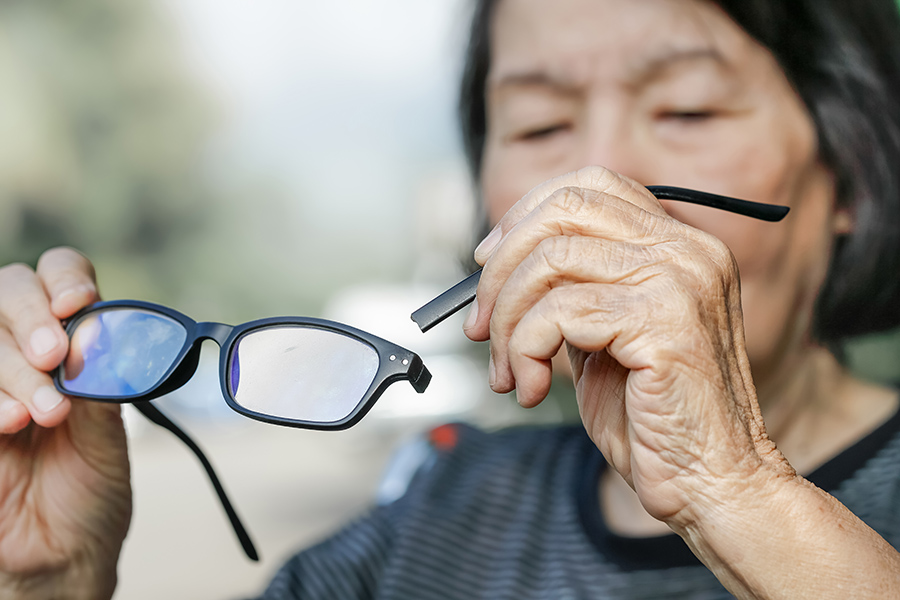June is National Alzheimer’s and Brain Awareness Month, a global effort to promote education regarding neurological conditions for doctors, patients, and caregivers alike. Together, we can provide support for those who live with this disease and their dedicated caregivers.
History
Much of what we know historically about Alzheimer’s Disease comes from research done primarily on men. Ever since Dr. Alois Alzheimer published the first study on Alzheimer’s in 1907, a majority of scientists have studied its effects exclusively on men[1] in order to eliminate potential variables in their studies. Modern research has been working to close the information gap of how the disease effects men and women differently, but there is still a lot we don’t know.
Researchers have examined a number of different factors that may contribute to Alzheimer’s Disease and discovered that the disease exhibits some sex-specific differences. These variations are spread across different aspects of Alzheimer’s, including:
- Risk factors (both biological and social)
- Diagnosis timeline
- Pathogenesis
Despite a large portion of early research having been conducted on men, an estimated two-thirds of all Alzheimer’s patients are women. This suggests that the disease is a combination of genetic, hormonal, biological, and social factors that influence the pathogenesis in men and women in different ways.
What is Alzheimer’s Disease?
Alzheimer’s Disease (AD) is a degenerative brain disease categorized by loss of brain functions due to a buildup of proteins in the brain. Symptoms of Alzheimer’s include, but are not limited to:
- Memory loss
- Difficulty completing once-simple tasks (ex. Brushing your teeth or making the bed)
- Confusion
- Difficulty speaking or writing
- Changes in mood or personality
Risk Factors
Aging
The number one risk factor of AD is aging, regardless of sex[2]. As we age, we begin to see a natural decrease in levels of androgens and estrogens within the body. Researchers believe that these both provide certain protective qualities for the brain, specifically in cognitive function and resilience to neurological decline[3]. As men age, there is a natural decrease in testosterone, which links aging with a higher risk of AD[4].
Hormonal Risk Factors
Aging isn’t the only way to decrease androgen and estrogen levels; qualifying events can also impact hormone levels within the body. These might include:
- Menopause/Andropause
- Depletion of hormones due to surgery (i.e. hysterectomies, orchiectomies, etc.)
- Medication side effects
The most notable disruption to hormone levels in the body is menopause. While men do not experience menopause, they do experience reproductive aging over the course of several decades, also known as andropause. In men, we see a decline in testosterone at an average rate of about 1% per year after the age of 40[5].
While this decrease is typically not enough to cause serious health complications, the loss of testosterone can have surprising effects on the brain.
Some symptoms of low testosterone may include:
- Decreased libido
- Low energy
- Issues with self-confidence
- Trouble sleeping
Some of these symptoms have a direct correlation with increased risk factors for AD—such as lack of sleep—while others are not as clear. For example, lack of self-confidence can cause or worsen the following[6]:
- Social isolation
- Depression
- Substance abuse
The above symptoms can all increase the risk of developing AD, however they often go untreated due to the social stigma around men’s mental health issues.
Hormone Replacement
Additional research demonstrates an inverse correlation between brain levels of testosterone and the soluble Aβ[7], which is a naturally occurring protein that can cause a decline in neurological functions when accumulated in the brain. Androgen-deprivation therapy (ADT)—a treatment commonly used to treat prostate cancer—has been proven to increase plasma levels of Aβ. A recent study found that men receiving ADT treatment were at a higher risk for developing AD than men not receiving ADT.
This supports the theory that there is a correlation between the loss of testosterone and the buildup of Aβ in the brain—which is a known factor in the development of AD[8]. Despite these findings, researchers are still unsure of the scope of the relationship between testosterone and AD risk.
Vascular Risk Factors
There is much discussion in the scientific community on the relationship between vascular conditions and AD, as researchers recognize there is a pathological overlap between the two. Examples of such vascular conditions include:
- Vascular lesions (specifically subcortical white matter lesions)
- Stroke
- Atrial fibrillation
- Coronary heart disease
- High blood pressure
Men who have these conditions face a higher risk of developing AD than those without, as studies have linked damage to neurovascular cells with an increase of proteins in the brain[9] which is a major factor in the pathogenesis of Alzheimer’s. The onset of vascular disorders in the pre-clinical stages of AD suggests it may cause the disease rather than just contribute to its development[10], however more research is needed to confirm this theory.
Social Risk Factors
Our social lives also have a part to play in the development of AD, and certain social factors can have physical manifestations within the body that increase the risk of Alzheimer’s. These factors may include:
- Higher education and related opportunities
- Career involvement
- Stress
- Social isolation
For example, studies have shown that access to higher education can reduce your chances of developing AD and other types of dementia through advanced opportunities for the increase of cognitive reserve. Cognitive reserve refers to the brain’s mental agility and can be developed over time through various forms of mental stimulation, such as:
- Classroom learning
- Research
- Access to jobs
Historically, men have had better access to these institutions, which could explain why men tend to have a higher cognitive reserve than women.
The larger the cognitive reserve, the more a person can offset brain degeneration and extend the time they are able to survive with a neurological condition. Since men are more likely to have a larger cognitive reserve than women, they are therefore better equipped to slow down the progression of AD, which would explain why men do not experience the symptoms of neurological decline with the same severity that women do[11].
The Future of Alzheimer’s
Despite researchers’ best efforts, we are still lacking a lot of information regarding Alzheimer’s Disease. The clear discrepancies in disease occurrence and pathogenesis suggest we have a lot of work to do before we fully understand the effects of AD. While there is currently no cure for Alzheimer’s, maybe a solution lies in the unknown, just waiting to be discovered.
Resources
If you or a loved one is suffering from Alzheimer’s Disease, there are resources available to help you.
- Alzheimer’s Association Website (includes a 24/7 helpline)
- Alzheimer’s Foundation of America (includes 24/7 helpline)
- Shield Healthcare Community Site
Sources
- Alois Alzheimer: His Life and Times – PMC
- Alois Alzheimer and Alzheimer’s disease: a centennial perspective
- Pathogenesis – Critical Needs and Gaps in Understanding Prevention, Amelioration, and Resolution of Lyme and Other Tick-Borne Diseases – NCBI Bookshelf
- 10 Early Signs and Symptoms of Alzheimer’s & Dementia | alz.org
- Why is dementia different for women? | Alzheimer’s Society
- Androgens: Function, Levels & Related Disorders
- Estrogen: Hormone, Function, Levels & Imbalances
- Male menopause: Myth or reality? – Mayo Clinic
- Differences Between Women and Men in Incidence Rates of Dementia and Alzheimer’s Disease – PMC
- Why men often die earlier than women – Harvard Health
- Journal of Neuroscience Research | JNR Neuroscience Journal | Wiley Online Library
- Hormone Therapy for Prostate Cancer | American Cancer Society
- Sexual dimorphism | Definition, Examples, & Facts | Britannica
- Hippocampus: What It Is, Function, Location & Damage
- Vascular Disease: Types, Causes, Symptoms and Treatment
- White Matter Disease: What It Is, Symptoms & Treatment
- Stroke – Symptoms and causes – Mayo Clinic
- Atrial fibrillation – Symptoms and causes – Mayo Clinic
- Coronary Heart Disease – What Is Coronary Heart Disease? | NHLBI, NIH
- White Matter Damage in Alzheimer’s Disease: Contribution of Oligodendrocytes – PMC
- Study reveals how APOE4 gene may increase risk for dementia | National Institute on Aging
- Do Men Have a Higher Risk for Heart Disease?: Louisiana Heart and Vascular: Interventional Cardiologists
- What is cognitive reserve? – Harvard Health
- Special Heart Risks for Men | Johns Hopkins Medicine
- Alzheimer’s Association | Alzheimer’s Disease & Dementia Help
- Alzheimer’s Foundation of America | Homepage
- All Communities | Shield HealthCare
- Sleep deficiency promotes Alzheimer’s disease development and progression – PMC
- Vascular dysfunction in Alzheimer’s disease: a biomarker of disease progression and a potential therapeutic target – PMC
[1] Alzheimer’s Society “Why is Dementia Different for Women?”
[2] Alzheimer’s Society “Why is Dementia Different for Women?”
[3] Christian J. Pike “Sex and the Development of Alzheimer’s Disease”
[4] Christian J. Pike “Sex and the Development of Alzheimer’s Disease”
[5] Mayo Clinic “Male Menopause: Myth or Reality?”
[6] Katherine Bourzac “Why Women Experience Alzheimer’s Disease Differently from Men”
[7] Christian J. Pike “Sex and the Development of Alzheimer’s Disease”
[8] Christian J. Pike “Sex and the Development of Alzheimer’s Disease”
[9] Govindpani et al. “Vascular Dysfunction in Alzheimer’s Disease”
[10] Govindpani et al. “Vascular Dysfunction in Alzheimer’s Disease”
[11] Harvard Health Publishing “What is Cognitive Reserve?”






















